NIH Building 1 (James A. Shannon Building)
Introduction
Text-to-speech Audio
Images
Mrs. Helen Wilson, who, with her husband Luke Wilson, donated the first land for the NIH campus at Bethesda, waves from an excavator on January 11, 1938. She is wearing Black because of her husband’s death in August, 1937.
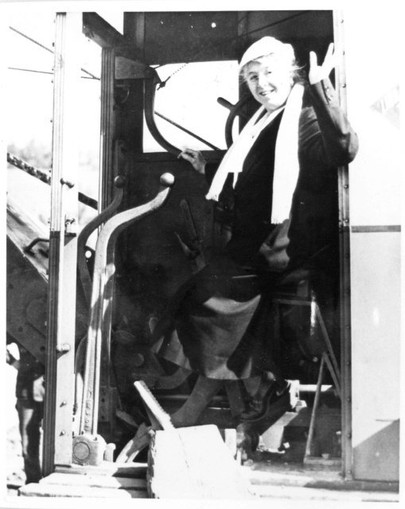
Building 1 under construction, winter 1938.
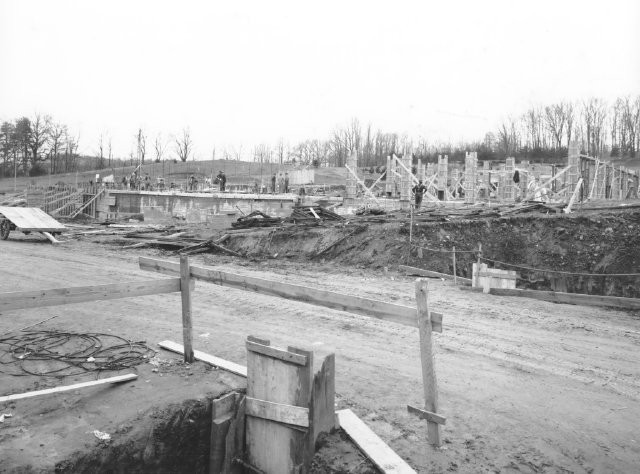
Henry Morgenthau, Secretary of the Treasury (left); Mrs. Helen Wilson (center); and Surgeon General Dr. Thomas Parran laying the cornerstone of Building 1, June 30, 1938.

Photograph of Building 1 taken shortly after its completion, ca. 1940-1950. Photographer: Roy Perry.
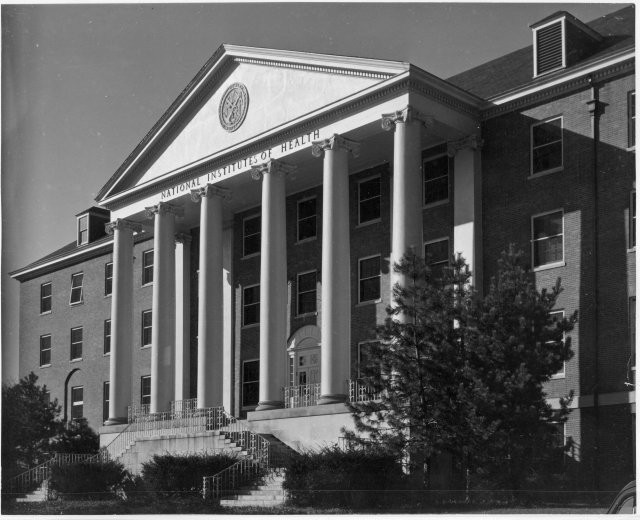
President Franklin Roosevelt delivers a speech dedicating the NIH campus in Bethesda from the portico of Building 1, October 31st, 1940.
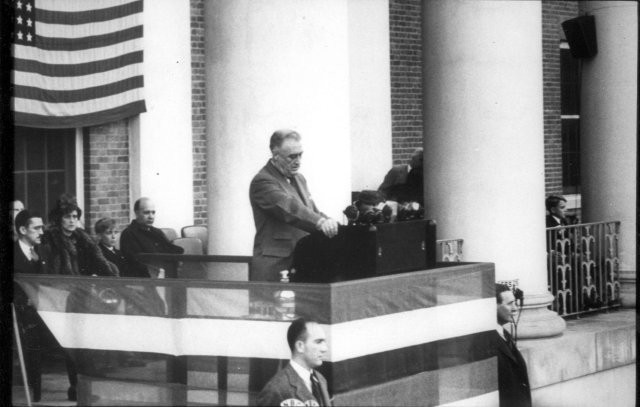
Bust of James Shannon, sculpted by Elaine Pear Cohen (1976). The bust is on display in the lobby of Building 1.
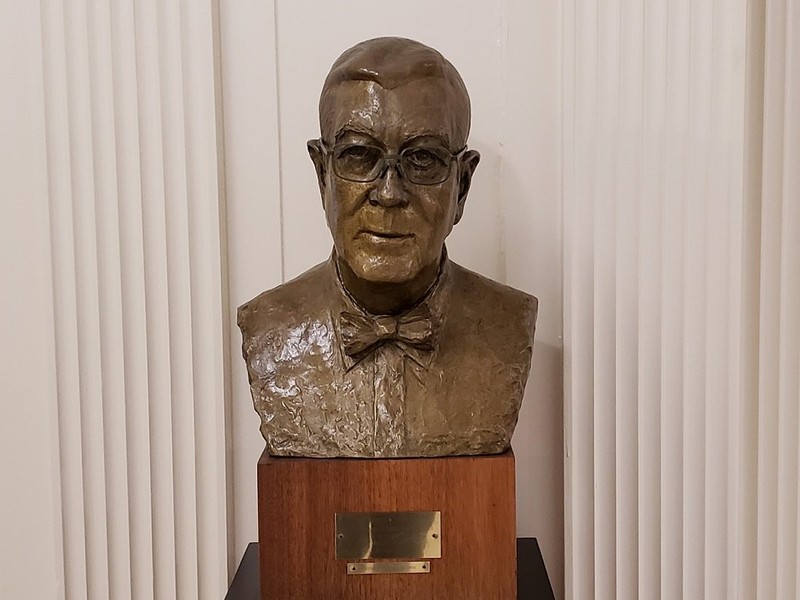
Photograph of the Shannon Building as seen today, ca. 2010. Photographer: Bill Branson.

Backstory and Context
Text-to-speech Audio
The National Institute of Health (NIH - then singular) moved from its cramped and crumbling facilities at 25th and E streets, NW in downtown Washington after receiving over $1 million in construction funding from the Social Security Act of 1935 and a generous donation of land in Bethesda from Helen and Luke Wilson.
At the time of its original construction, Building 1 served a multitude of purposes. It housed the office of the NIH director, contained the library and cafeteria, held workshops for carpenters, electricians, and plumbers, and provided space for the campus’ boiler plant. The basement contained research laboratories that featured proper ventilation systems and fume hoods and a special camera which allowed researchers to take pictures of microscopic subjects. The auditorium, named Wilson Hall in honor of the Wilson family, served as a gathering place for NIH researchers and featured a film projector. But the hall wasn’t the only place for staff gatherings – a baseball field was created behind the building for staff to play games at lunch.
Construction of Building 1 was fast, but not without fault. Unfamiliar with new technology, contractors struggled to install lab equipment. An accident caused a broken water pipe in the kitchen to leak into the library below doing $7000 worth of damage to the books. The most dramatic incident happened on April 18, 1938. While digging trenches for a storm sewer, a crane toppled over. The operator hastily jumped from the crane, but another worker was trapped underneath. A plumber, surprised by the crash, dropped a torch and ignited the gas leaking from the crane. Fire trucks rushed to the scene, extinguishing the flames and rescuing the trapped worker. Amazingly, the only injury sustained was a cut below the trapped worker’s eye. One contractor in a letter to an engineer offered his opinion on the construction experience when he wrote, “This job was one of those unfortunate experiences which all businessmen go through from time to time. It just seemed everything went wrong from the start” (Letter from J.S. Dougherty, W.F. Dougherty & Sons, to Mr. Henry R. Leslie, Construction Engineer, NIH, May 2, 1940). Despite the difficulty, construction of the building was completed in a mere eleven months.
Roosevelt Dedication:
In October of 1940, construction of the original NIH campus (Buildings 1-6) was nearly finished. Wayne Coy, Acting Federal Property Administrator, thought the President should dedicate NIH’s new campus. He wrote to President Roosevelt, suggesting, “It seems to all of us that in this time of our great efforts toward military preparedness, that it would be most appropriate for you to bring to the attention of the people of the country the fact that peacetime preparedness against diseases is not being neglected” (Letter to President Roosevelt, dated October 15, 1940). On October 31st, speaking from the portico of Building 1, Roosevelt dedicated the NIH to “furthering the health of all mankind”. At the bottom of this page, you will find links to both audio and video recordings of the speech.
Dedication to James A. Shannon:
On January 18th, 1983, Building 1 was renamed in honor of Dr. James A. Shannon. Well known for his antimalarial research during World War II, Shannon was recruited to be Associate Director of the recently founded National Heart Institute, part of the NIH, in 1949. He quickly went to work setting research priorities and recruiting staff; within three years, he was put in charge of all intramural research at NIH. In 1955, Shannon was appointed director of the entire NIH. At the dedication of Building 1 to Shannon, Dr. James Wyngaarden (NIH Director, 1982-1989) recounted that Shannon’s appointment was rather informal, stating, “Surgeon General Scheele approached Dr. Shannon asking if he would like to head NIH. Responding affirmatively, Dr. Shannon asked when. To which Dr. Scheele replied ‘How about Monday!’ And it was done” (Building One Renamed for Dr. James A. Shannon, NIH Record, Feb. 1st, 1983).
Under Dr. Shannon’s administration, NIH’s
operational budget soared from $65 million to $1.3 billion. The number of
research grants disbursed by NIH increased from 3,300 to 12,600, and the value
of each grant increased from $10,000 to $50,000. NIH added 7,000 members to its
research staff, and over $1 billion dollars were given to the NIH for new
construction.
Sources
Lyons, Michele. 70 Acres of Science: The National Institute of Health Moves to Bethesda. 2006. Accessed September 24, 2018. https://history.nih.gov/research/downloads/70acresofscience.pdf.
“Building Group is Designed for Health Institute,” Washington Post. August 27, 1937: p. 15
“Parran Launches Health Institute,” Washington Evening Star. January 11, 1938: p. A2
“Ground Broken for New Home of National Institute of Health,” Washington Post. January 12, 1938: p. 17
“Building One Renamed for Dr. James A. Shannon,” NIH Record. February 1, 1983: p. 3
Kennedy, Thomas J., Jr. James Augustine Shannon, 1904-1994: A Biographical Memoir. Washington, DC: National Academies Press, 1998. Accessed September 24, 2018. http://www.nasonline.org/publications/biographical-memoirs/memoir-pdfs/shannon-james.pdf
